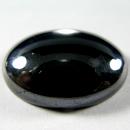|
|
||||||||||||||||
|
||||||||||||||||
|
||||||
|
|
|
|
Alabandite
|
|
| | |
| Discovered in 1832; IMA status: Valid (pre-IMA; Grandfathered) | ||
|
| ||
|
Chemistry |
|
|
| |
|
Mn2+S | |
|
|
Manganese Sulfide |
|
Molecular Weight: |
87.00 gm |
|
Composition: |
Manganese |
63.14 % |
Mn |
|
|
|
|
Sulfur |
36.86 % |
S |
|
|
|
|
|
100.00 % |
|
|
|
|
|
|
||||
|
Classification |
|
|
| |
|
Sulfides | |
|
2/C.15-30 | |
|
|
2 : SULFIDES and SULFOSALTS (sulfides, selenides,
tellurides; arsenides, antimonides, bismuthides; sulfarsenites,
sulfantimonites, sulfbismuthites, etc.) |
|
Related to: |
Galena Group. Dimorphous with Rambergite. |
|
Members of Group: |
Galena Group: Alabandite, Altaite, Clausthalite, Galena, Niningerite, Oldhamite |
|
Varieties: |
None |
|
Synonyms: |
Alabandine, Alabandite (of Beudant), Glance-blende, Manganblende |
|
|
|
|
Crystal Data |
|
|
|
|
|
Crystals cubic or octahedral, to 1 cm. Commonly massive, granular. |
|
|
Lamellar || {111} |
|
|
|
|
|
Physical Properties |
|
|
|
|
|
Perfect on {001} |
|
|
Irregular/Uneven |
|
|
Brittle |
|
|
3.5 - 4.0; VHN = 164–174, 167 average (100 g load) |
|
|
3.95 - 4.04 (g/cm3) |
|
|
None |
|
|
Not Radioactive |
|
|
|
|
|
Optical Properties |
|
|
|
|
|
Iron-Black, tarnishing Brown; in polished section, Gray-White; deep Green to Brown and Red in thin slivers. |
|
|
Opaque, but Translucent in very thin fragments. |
|
|
Sub-Metallic |
|
|
2.70 Isotropic |
|
|
0.00 Isotropic |
|
|
None |
|
|
None |
|
|
Other: |
Color in reflected light: white to gray |
|
|
|
|
Occurances |
|
|
|
|
|
Geological Setting: |
May be in large quantities in epithermal polymetallic sulfide vein and especially in low-temperature manganese deposits. An uncommon constituent of a number of meteorites. |
|
Common Associations: |
Galena, Chalcopyrite, Sphalerite, Pyrite, Acanthite, Tellurium, Rhodochrosite, Calcite, Rhodonite, Quartz |
|
Common Impurities: |
Fe, Mg, Co |
|
Type Locality: |
Sacarîmb (Săcărâmb; Szekerembe; Nagyág), Hunedoara Co., Romania
|
|
Year Discovered: |
1832 |
|
View mineral photos: | |
|
|
|
|
More Information |
|
|
|
|
|
| |
|
|
|
|
Selected
localities include Alabanda, 30 km south-southeast of
Aydin, Aydin Province, Turkey. At Baia-de-Aries (Offenbánya),
Săcărîmb (Nagyág), and Cavnic (Kapnikbánya), Romania.
From Adervielle, Hautes-Pyrénées, France. At Gersdorf,
Saxony, Germany. From manganese mines in Val Graveglia,
Liguria, Italy. At Nsuta, Ghana. In the Yakumo and Inakuraishi
mines, Hokkaido; the Taisei mine, Akita Prefecture;
and many other localities in Japan. From Broken Hill,
New South Wales, Australia. In Peru, at Morococha, Junin.
In the Preciosa mine, Tlalchichuca, Puebla, and at Onovas,
Sonora, Mexico. In the USA, in the Lucky Cuss mine,
Tombstone, Cochise County, Arizona; the Queen of the
West mine, Summit County, Colorado; at Schellbourne,
White Pine County, Nevada; and from Butte, Silver Bow
County, Montana. |
|
|
We
have not photographed the Alabandite gems yet. Please
check back soon. |
